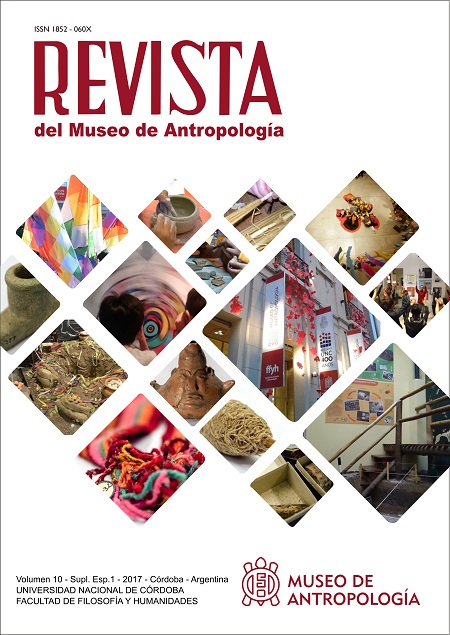Relationships between the populations of Hualfín Valley (Belén, Catamarca province) and those located to the south. A case study from a Sanagasta vessel
DOI:
https://doi.org/10.31048/1852.4826.v10.n0.13571Keywords:
Sanagasta pottery, Hualfín Valley, interregional relationships, ceramic analysis, neutron activation analysisAbstract
The links between late inhabitants from Hualfín Valley and populations located at the south were habitually mentioned in bibliography, mainly based in ethnohistoric information, but also in ceramics. In Loma de Ichanga, a late site located in La Ciénaga (Hualfín Valley, Catamarca, Argentina), dated in 420 ± 50 BP (LP1832), a Sanagasta vessel was found, in a context that have been interpreted as planned and ritual abandonment with a fire. The neutron activation analysis and the petrographic information led us to establish that the vessel was manufactured with raw materials that are different from those used in local vessels, and let us to think in a foreign origin, probably form Abaucán valley (Catamarca) or La Rioja and San Juan provinces. Finally, we consider deeper cultural and temporal relations between inhabitants than the population politics led by Inka Empire.Downloads
References
Balesta, B. y F. Wynveldt. 2010. Defensibilidad, visibilidad y abandono en la Loma de Ichanga del Valle de Hualfín (Depto. de Belén, Prov. de Catamarca, Argentina). Revista Española de Antropología Americana 40(1): 53-71.
González, A. R. 1967. Una excepcional pieza del mosaico cultural del N. O. argentino. Consideraciones sobre la secuencia arqueológica de la Prov. de San Juan. Etnía 6.
Hogg, A; Q. Hua ; P. Blackwell; M. Niu; C. Buck; T. Guilderson; T. Heaton; J. Palmer; P. Reimer; R. Reimer; C. Turney; S. Zimmerman. 2013. SHCal13 Southern Hemisphere Calibration, 0–50,000 years cal BP. Radiocarbon 55(4): 1889–1903.
Iucci, M. E. 2013. “Producción, circulación y uso de cerámica tardía del Valle de Hualfín. Catamarca, Argentina”. Facultad de Ciencias Naturales y Museo, Universidad Nacional de La Plata, Argentina: 572 p. Tesis de Doctorado. SEDICI (Repositorio Institucional de la UNLP) http://sedici.unlp.edu.ar/handle/10915/35235.
Ratto, N., A. Feely y M. Basile. 2007. Coexistencia de diseños tecno-estilísticos en el Período Tardío Preincaico: el caso del entierro en urna del bebé de La Troya (Tinogasta, Catamarca, Argentina). Intersecciones en Antropología 8: 69.85.
Revuelta, C. 2009. Informe material arqueológico Campanas. M.s.
Revuelta, C. M., S. A. Carosio y J.P. Aguilar. 2010-2011. Formas y representaciones tardías. Aproximaciones a una mirada integral al estilo cerámico Sanagasta – Angualasto. Anales de Arqueología y Etnología 65-66: 57-85.
Sempé, M. C. 2005. El Período Tardío en Azampay: el señorío Belén y su modelo geopolítico. Sempé, M. C., S. Salceda y M. Maffia. Azampay. Presente y pasado de un pueblito catamarqueño, 365-380. Ediciones Al Margen, La Plata.
Sempé, C., G. Méndez y S. Salceda. 1995-1996. Entierro intrusivo en Barrealito de Azampay. Shincal 5: 43-49.
Valencia, M. C; M. Fernández y C. Barberis. 2010. Evidencias de Incendios en el registro arqueológico de La Ciénaga. B. Balesta y N. Zagorodny, Aldeas protegidas, conflicto y abandono. Investigaciones arqueológicas en La Ciénaga (Catamarca), capítulo 4, 161-199. Ediciones Al Margen, La Plata.
Downloads
Published
Issue
Section
License
Those authors who have publications with this Journalaccept the following terms:
a. Authors will retain their copyrights and guarantee the journal the right of first publication of their work, which will be simultaneously subject to the Creative Commons Attribution License (Licencia de reconocimiento de Creative Commons) that allows third parties to share the work as long as its author and his first publication in this journal.
b. Authors may adopt other non-exclusive licensing agreements for the distribution of the version of the published work (eg, deposit it in an institutional electronic file or publish it in a monographic volume) provided that the initial publication in this journal is indicated.
c. Authors are allowed and recommended to disseminate their work on the Internet (eg in institutional telematic archives or on their website) before and during the submission process, which can lead to interesting exchanges and increase citations of the published work. (See The Effect of Open Access - El efecto del acceso abierto)












